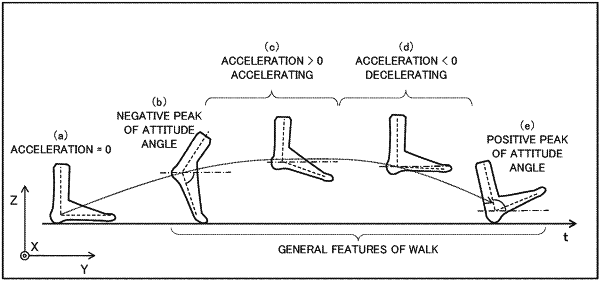| CPC G01C 23/00 (2013.01) [A61B 5/1123 (2013.01); G01D 1/12 (2013.01); G01D 1/16 (2013.01); G01D 1/18 (2013.01)] | 8 Claims |

|
1. A walk discrimination device comprising:
at least one memory storing instructions; and
at least one processor connected to the at least one memory and configured to execute the instructions to:
receive sensor data including an acceleration and an angular velocity acquired by a sensor installed in a shoe of a user;
calculate an attitude angle by use of the acceleration and the angular velocity included in the sensor data;
in response to the attitude angle exceeding a threshold, start a walk determination process based on a determination order that detecting a negative peak in the attitude angle, changing the acceleration to positive, changing the acceleration to negative, and detecting a positive peak in the attitude angle in this order;
when the determination order is satisfied, determine that the user is walking;
when the determination order is not satisfied, determine that the user is not walking;
output a first acceleration signal in response to the acceleration included in the sensor data is positive, and output a second acceleration signal in response to the acceleration included in the sensor data is negative, output an over-threshold signal in response to the attitude angle exceeding the threshold, output a first attitude angle signal in response to a detection of a negative peak of the attitude angle, output a second attitude angle signal in response to a detection of a positive peak of the attitude angle, and
determine that a walk has been performed in response to a sequential receipt of the first attitude angle signal, the first acceleration signal, the second acceleration signal, and the second attitude angle signal after receiving the over-threshold signal and the second attitude angle signal after receiving the over-threshold signal; and
output information including a discrimination result indicating whether the user is walking or not.
|